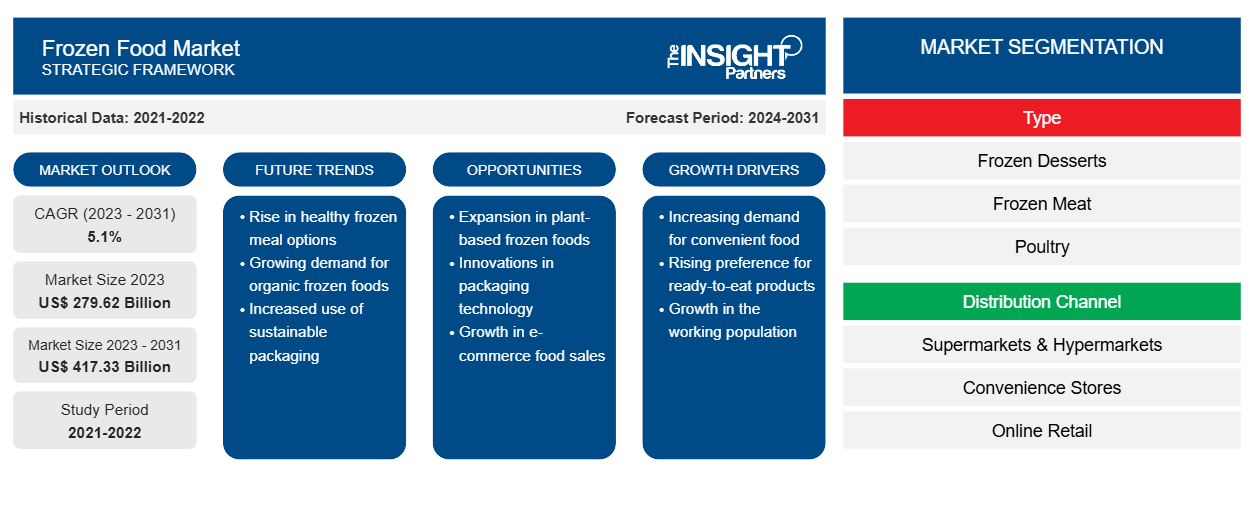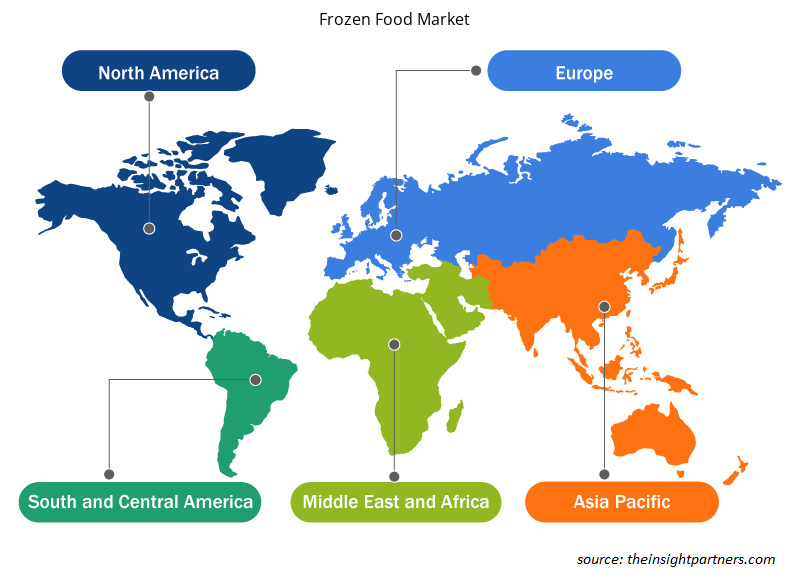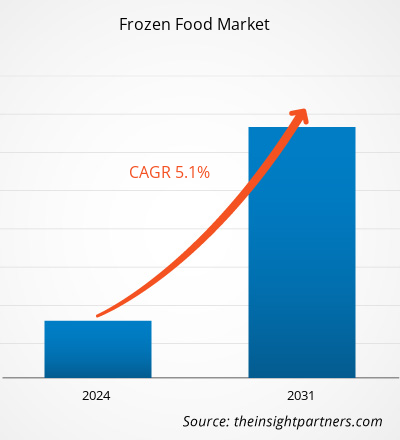Se espera que el tamaño del mercado de alimentos congelados alcance los 444,22 millones de dólares estadounidenses para 2031, desde los 295,39 millones de dólares estadounidenses de 2024; es probable que registre una tasa de crecimiento anual compuesta (TCAC) del 6,0 % durante el período de pronóstico. El veganismo ha cobrado un impulso significativo en los últimos años. Los consumidores se inclinan con mayor frecuencia por los productos de origen vegetal, ya que los perciben como más saludables que los productos convencionales. Además, la creciente concienciación sobre la protección animal y la sostenibilidad ambiental está impulsando la popularidad de estos productos alimenticios. La proliferación del veganismo en todo el mundo está influyendo significativamente en las innovaciones en el mercado de alimentos congelados.
Análisis del mercado de alimentos congelados
En los últimos años, el estilo de vida de las personas en todo el mundo ha evolucionado drásticamente. Debido a los horarios laborales ajetreados, ha aumentado la dependencia de productos que ahorran tiempo y esfuerzo. El auge del consumo de comida preparada de alta calidad es una de las tendencias más importantes en la industria alimentaria. La comida preparada, como los snacks congelados, las comidas congeladas, los embutidos y los productos listos para comer, permite a los consumidores ahorrar tiempo y esfuerzo en la compra de ingredientes, la preparación y cocción de las comidas, el consumo y las actividades posteriores. El desarrollo y la popularidad de estos alimentos se atribuyen a numerosos cambios sociales; los más notables son el creciente número de hogares más pequeños y el aumento de la población millennial en todo el mundo. Debido a los horarios laborales ajetreados, los millennials prefieren ser eficientes con su tiempo en lugar de dedicarlo a tareas tediosas. Por lo tanto, son más propensos a gastar su dinero en comida preparada. Estos factores están impulsando significativamente la demanda de comida preparada entre los consumidores, impulsando así el crecimiento del mercado de alimentos congelados.
Descripción general del mercado de alimentos congelados
Los alimentos congelados incluyen helados, yogur helado, carne congelada, mariscos congelados, platos preparados congelados, snacks, aperitivos, sopas, frutas y verduras. Estos productos se conservan congelándolos a aproximadamente -25 grados Celsius. No contienen conservantes artificiales, lo que los hace más saludables que otros alimentos procesados. Además, se pueden almacenar fácilmente en congeladores domésticos a una temperatura de 0 grados Fahrenheit. La creciente demanda de alimentos precocinados, debido al ritmo de vida ajetreado de las personas, está impulsando el crecimiento del mercado de alimentos congelados. Asimismo, la rápida urbanización, el aumento del ingreso per cápita y la evolución del mercado minorista son algunos de los factores clave que impulsan el crecimiento del mercado de alimentos congelados.
Personalice este informe según sus necesidades
Obtendrá personalización en cualquier informe, sin cargo, incluidas partes de este informe o análisis a nivel de país, paquete de datos de Excel, así como también grandes ofertas y descuentos para empresas emergentes y universidades.
Mercado de alimentos congelados: Perspectivas estratégicas

-
Obtenga las principales tendencias clave del mercado de este informe.Esta muestra GRATUITA incluirá análisis de datos, desde tendencias del mercado hasta estimaciones y pronósticos.
Impulsores y oportunidades del mercado de alimentos congelados
El auge del comercio electrónico favorece el mercado
Las personas prefieren cada vez más las plataformas de venta minorista en línea para comprar alimentos congelados. Según el Instituto Americano de Alimentos Congelados, las ventas en línea de productos congelados aumentaron un 75% en 2020. Las ventas en línea de alimentos y bebidas aumentaron significativamente durante la pandemia debido al cierre de las tiendas físicas y la imposición de restricciones sociales por parte de los gobiernos. Como los confinamientos limitaron la movilidad de las personas y las obligaron a trabajar desde sus hogares, se produjo una transición sustancial hacia las compras en línea. Además, los grandes descuentos, la amplia disponibilidad de diferentes marcas en un mismo lugar y las opciones de entrega a domicilio han sido otros factores notables que han impulsado el interés de los consumidores por las compras en línea. Con la creciente penetración del comercio electrónico en diferentes geografías, fabricantes de alimentos congelados como Kellogg's Company y Conagra Brands también están ampliando su presencia en línea vendiendo sus productos a través de plataformas de comercio electrónico reconocidas como Amazon.com, Lidl y Walmart. Este factor contribuye al crecimiento del mercado de alimentos congelados al eliminar la dependencia de las tiendas físicas.
Iniciativas de desarrollo estratégico de los fabricantes: una oportunidad
Los fabricantes de alimentos congelados están realizando importantes inversiones en innovación de productos para ampliar su cartera de clientes y satisfacer las nuevas tendencias de consumo. Están lanzando productos sin gluten, de origen vegetal, sin azúcar, orgánicos y de etiqueta limpia, así como productos aptos para la dieta keto, que satisfacen las diversas necesidades de los consumidores. Por ejemplo, en agosto de 2021, Real Good Foods Company, una empresa reconocida en la industria de los alimentos congelados, anunció el lanzamiento de siete nuevas categorías de productos congelados ricos en proteínas, bajos en carbohidratos, sin cereales y sin gluten en 1500 tiendas Kroger de Estados Unidos. De igual manera, en 2022, la marca india líder Prasuma, que ofrece alimentos congelados, incorporó snacks congelados a su cartera de productos. Los nuevos productos incluyen rollitos de primavera de verduras y pollo congelados, nuggets de pollo congelados, mini samosas de pollo y verduras, kebabs shammi de pollo y cordero y kebabs seekh, además de tocino. Estos productos se lanzaron para ayudar a los consumidores a mantener sus objetivos de salud y disfrutar de una buena alimentación, a la vez que la salud se convirtió en una prioridad para los consumidores de todo el mundo durante la crisis mundial. Dado que las personas han comenzado a centrarse en productos de comida preparada, manteniendo al mismo tiempo el equilibrio nutricional en sus dietas, los fabricantes están lanzando productos congelados enriquecidos nutricionalmente. Estas innovaciones les ayudan a ampliar su alcance y a obtener una ventaja competitiva en los mercados internacionales.
Análisis de segmentación del informe del mercado de alimentos congelados
Los segmentos clave que contribuyeron a la derivación del análisis del mercado de alimentos congelados son el tipo y el canal de distribución.
- Según el tipo, el mercado de alimentos congelados se divide en postres congelados, carne, aves y mariscos congelados, panadería congelada, aperitivos y snacks congelados, comidas congeladas y otros.
- En términos de canal de distribución, el mercado se divide en supermercados e hipermercados , tiendas de conveniencia, venta minorista en línea y otros.
Análisis de la cuota de mercado de alimentos congelados por geografía
El alcance geográfico del informe del mercado de alimentos congelados se divide principalmente en cinco regiones: América del Norte, Asia Pacífico, Europa, Medio Oriente y África, y América del Sur / América del Sur y Central.
Europa ha dominado el mercado de alimentos congelados. Este mercado se divide en Alemania, Francia, Italia, Reino Unido, Rusia y el resto de Europa. El crecimiento del mercado se atribuye principalmente a la creciente demanda de alimentos preparados, la amplia infraestructura minorista y la disponibilidad de una amplia gama de productos de diferentes marcas en diversos canales de distribución. Además, la presencia de consumidores con altos ingresos per cápita también impulsa la demanda de alimentos congelados, como comidas congeladas y refrigerios. Los consumidores buscan beneficios nutricionales en los productos que consumen. Por lo tanto, la demanda de alimentos congelados limpios, orgánicos, sin gluten y mínimamente procesados ha aumentado significativamente, lo que impulsa el crecimiento del mercado en la región.
Perspectivas regionales del mercado de alimentos congelados
Los analistas de Insight Partners han explicado detalladamente las tendencias y los factores regionales que influyen en el mercado de alimentos congelados durante el período de pronóstico. Esta sección también analiza los segmentos y la geografía del mercado de alimentos congelados en América del Norte, Europa, Asia Pacífico, Oriente Medio y África, y América del Sur y Central.

- Obtenga los datos regionales específicos para el mercado de alimentos congelados
Alcance del informe del mercado de alimentos congelados
| Atributo del informe | Detalles |
|---|---|
| Tamaño del mercado en 2024 | US$ 295,39 millones |
| Tamaño del mercado en 2031 | US$ 444,22 millones |
| CAGR global (2025-2031) | 6.0% |
| Datos históricos | 2021-2023 |
| Período de pronóstico | 2025-2031 |
| Segmentos cubiertos |
Por tipo
|
| Regiones y países cubiertos |
América del norte
|
| Líderes del mercado y perfiles de empresas clave |
|
Densidad de actores del mercado de alimentos congelados: comprensión de su impacto en la dinámica empresarial
El mercado de alimentos congelados está en rápido crecimiento, impulsado por la creciente demanda del consumidor final debido a factores como la evolución de las preferencias del consumidor, los avances tecnológicos y una mayor conciencia de los beneficios del producto. A medida que aumenta la demanda, las empresas amplían su oferta, innovan para satisfacer las necesidades del consumidor y aprovechan las tendencias emergentes, lo que impulsa aún más el crecimiento del mercado.
La densidad de actores del mercado se refiere a la distribución de empresas o compañías que operan en un mercado o sector en particular. Indica cuántos competidores (actores del mercado) hay en un mercado determinado en relación con su tamaño o valor total.
Las principales empresas que operan en el mercado de alimentos congelados son:
- Marcas Conagra
- General Mills
- Pepperidge Farm Incorporated
- Grupo Bonduelle
- McCain Foods Limited
- Alimentos Bellisio, Inc.
Descargo de responsabilidad : Las empresas enumeradas anteriormente no están clasificadas en ningún orden particular.

- Obtenga una descripción general de los principales actores clave del mercado de alimentos congelados
Noticias y novedades del mercado de alimentos congelados
El mercado de alimentos congelados se evalúa mediante la recopilación de datos cualitativos y cuantitativos tras la investigación primaria y secundaria, que incluye importantes publicaciones corporativas, datos de asociaciones y bases de datos. A continuación, se presenta una lista de las novedades en el mercado de trastornos del habla y el lenguaje y sus estrategias:
- En 2022, White Castle amplía su oferta de alimentos minoristas a través de una asociación con Bellisio Foods; para llevar los icónicos aros de pollo a los minoristas de todo el país (Whistle Castle/Sitio web de la empresa)
Informe de mercado de alimentos congelados: cobertura y resultados
El informe "Tamaño y pronóstico del mercado de alimentos congelados (2021-2031)" ofrece un análisis detallado del mercado que abarca las siguientes áreas:
- Tamaño del mercado y pronóstico a nivel global, regional y nacional para todos los segmentos clave del mercado cubiertos bajo el alcance
- Dinámica del mercado, como impulsores, restricciones y oportunidades clave
- Principales tendencias futuras
- Análisis detallado PEST/de las cinco fuerzas de Porter y FODA
- Análisis del mercado global y regional que cubre las tendencias clave del mercado, los principales actores, las regulaciones y los desarrollos recientes del mercado.
- Análisis del panorama de la industria y la competencia que abarca la concentración del mercado, el análisis de mapas de calor, los actores destacados y los desarrollos recientes.
- Perfiles detallados de empresas
- Análisis histórico (2 años), año base, pronóstico (7 años) con CAGR
- Análisis PEST y FODA
- Tamaño del mercado, valor/volumen: global, regional y nacional
- Industria y panorama competitivo
- Conjunto de datos de Excel
Informes recientes
Informes relacionados
Testimonios
Razón para comprar
- Toma de decisiones informada
- Comprensión de la dinámica del mercado
- Análisis competitivo
- Información sobre clientes
- Pronósticos del mercado
- Mitigación de riesgos
- Planificación estratégica
- Justificación de la inversión
- Identificación de mercados emergentes
- Mejora de las estrategias de marketing
- Impulso de la eficiencia operativa
- Alineación con las tendencias regulatorias






















 Obtenga una muestra gratuita para - Mercado de alimentos congelados
Obtenga una muestra gratuita para - Mercado de alimentos congelados